Venn diagram on prokaryotic and eukaryotic cells – Venn diagrams, powerful visual tools for comparing sets, unveil the fundamental differences between prokaryotic and eukaryotic cells. These diverse cell types, with their distinct structural features, genetic material, and metabolic processes, form the foundation of life’s rich tapestry.
As we delve into the intricacies of these cellular realms, the venn diagram on prokaryotic and eukaryotic cells will guide our exploration, revealing the unique characteristics that set them apart.
Introduction
A Venn diagram is a graphical representation of the similarities and differences between two or more sets. It is a useful tool for comparing and contrasting complex concepts or objects.
Prokaryotic and eukaryotic cells are two distinct types of cells that exhibit fundamental differences in their structure, function, and organization. Prokaryotic cells are simpler and lack a nucleus, while eukaryotic cells are more complex and have a nucleus.
Structural Features

| Feature | Prokaryotic Cell | Eukaryotic Cell | Shared Features |
|---|---|---|---|
| Cell Size | Smaller (typically 1-10 micrometers) | Larger (typically 10-100 micrometers) | – |
| Shape | Variable, often spherical or rod-shaped | Variable, often specialized for specific functions | – |
| Nucleus | Absent | Present, enclosed within a nuclear membrane | – |
| Cytoplasm | Contains ribosomes and other organelles | Contains ribosomes, organelles, and cytoskeleton | – |
| Organelles | Few, if any | Numerous, including mitochondria, endoplasmic reticulum, Golgi apparatus | – |
| Cell Membrane | Single, phospholipid bilayer | Single, phospholipid bilayer with embedded proteins and carbohydrates | – |
| Ribosomes | 70S | 80S | – |
Genetic Material: Venn Diagram On Prokaryotic And Eukaryotic Cells

Prokaryotic cells have a single, circular chromosome located in the cytoplasm. Eukaryotic cells have multiple, linear chromosomes located within the nucleus.
Prokaryotic cells also have plasmids, which are small, circular DNA molecules that are not essential for cell survival. Eukaryotic cells do not have plasmids.
Reproduction and Cell Division

Prokaryotic cells reproduce by binary fission, a process in which the cell simply divides in two. Eukaryotic cells reproduce by mitosis, a more complex process that involves the formation of spindle fibers and the separation of chromosomes.
Metabolism and Energy Production
Prokaryotic cells can obtain energy through a variety of mechanisms, including glycolysis, fermentation, and cellular respiration. Eukaryotic cells obtain energy primarily through cellular respiration.
Examples and Applications

Prokaryotic cells include bacteria and archaea. Eukaryotic cells include animals, plants, fungi, and protists.
Venn diagrams are used in biology to classify and understand different types of cells. They can also be used to compare and contrast other complex concepts or objects.
FAQ Explained
What is the key difference between prokaryotic and eukaryotic cells?
The presence of a nucleus, a membrane-bound organelle housing the cell’s genetic material, is the defining characteristic that distinguishes eukaryotic cells from prokaryotic cells.
How do prokaryotic cells reproduce?
Prokaryotic cells reproduce through binary fission, a simple process involving the division of the cell into two identical daughter cells.
What is the role of the cell membrane in eukaryotic cells?
The cell membrane in eukaryotic cells regulates the movement of substances into and out of the cell, maintaining its internal environment and protecting it from external threats.
